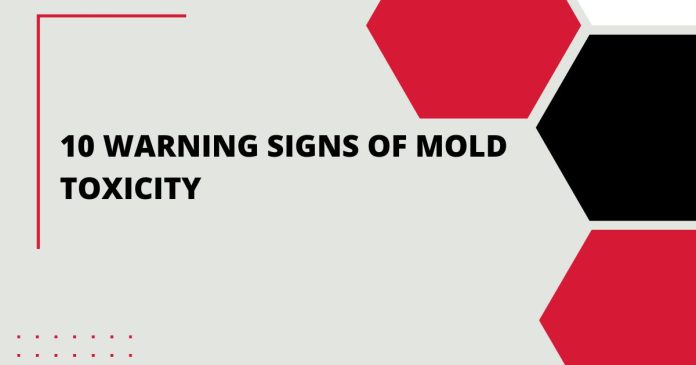Introduction
Mold is a common and naturally occurring organism that thrives in damp and humid environments. While it plays a crucial role in breaking down organic matter, mold can become a health concern when it grows indoors and releases toxic substances called mycotoxins. Exposure to mold and mycotoxins can lead to various health issues, and it’s important to be aware of the warning signs of mold toxicity. In this article, we will explore the top 10 warning signs of mold toxicity that indicate you may be experiencing mold toxicity.
Table of Contents
- Understanding Mold Toxicity
- The Dangers of Mycotoxins
- 10 Warning Signs of Mold Toxicity
- 3.1 Persistent Respiratory Issues
- 3.2 Allergic Reactions
- 3.3 Fatigue and Weakness
- 3.4 Headaches and Migraines
- 3.5 Skin Irritations
- 3.6 Cognitive Impairment
- 3.7 Digestive Problems
- 3.8 Sensitivity to Light and Noise
- 3.9 Increased Sensitivity to Odors
- 3.10 Mood Swings and Depression
- Diagnosing Mold Toxicity
- Preventing Mold Exposure
- Treatment and Recovery
- When to Seek Medical Help
- Creating a Mold-Free Environment
- FAQs About Mold Toxicity
Understanding Mold Toxicity
Mold toxicity refers to the adverse health effects caused by exposure to elevated levels of mold and mycotoxins. While some individuals may have a higher sensitivity to mold than others, prolonged exposure can lead to serious health problems.
The Dangers of Mycotoxins
Mycotoxins are toxic compounds produced by certain types of molds. These compounds can be released into the air and can contaminate indoor spaces. Inhaling or coming into contact with mycotoxins can result in various health symptoms.
10 Warning Signs of Mold Toxicity
3.1 Persistent Respiratory Issues
One of the most common signs of mold toxicity is persistent respiratory problems. Individuals exposed to mold may experience coughing, wheezing, shortness of breath, and a feeling of chest tightness.
3.2 Allergic Reactions
Mold exposure can trigger allergic reactions, causing symptoms such as sneezing, runny or stuffy nose, itchy and watery eyes, and throat irritation.
3.3 Fatigue and Weakness
Mold toxicity can lead to unexplained fatigue and weakness. Individuals may feel constantly tired even after getting enough sleep.
3.4 Headaches and Migraines
Frequent headaches and migraines can be indicative of mold toxicity. The presence of mycotoxins in the environment can trigger these debilitating headaches.
3.5 Skin Irritations
Skin rashes, hives, and other skin irritations can occur as a result of mold exposure. These skin issues may be accompanied by itching and redness.
3.6 Cognitive Impairment
Exposure to mold can affect cognitive function. Individuals may experience difficulties with concentration, memory, and decision-making.
3.7 Digestive Problems
Mold toxicity can also impact the digestive system, leading to symptoms such as nausea, vomiting, diarrhea, and abdominal pain.
3.8 Sensitivity to Light and Noise
Unusual sensitivity to light and noise can be a warning sign of mold toxicity. Individuals may find these sensory stimuli overwhelming.
3.9 Increased Sensitivity to Odors
Those experiencing mold toxicity may become more sensitive to odors, especially strong scents. This heightened sensitivity can trigger discomfort.
3.10 Mood Swings and Depression
Mold exposure has been linked to mood disturbances, including mood swings, anxiety, and even depression.
Diagnosing Mold Toxicity
Diagnosing mold toxicity can be challenging, as its symptoms overlap with other health conditions. Consulting a healthcare professional who specializes in environmental health is crucial for an accurate diagnosis.
Preventing Mold Exposure
Preventing mold exposure involves maintaining a dry and well-ventilated environment, fixing leaks promptly, using dehumidifiers, and regularly cleaning and inspecting your home for mold growth.
Treatment and Recovery
If diagnosed with mold toxicity, treatment may involve eliminating exposure, improving indoor air quality, and addressing any underlying health issues caused by mold exposure.
When to Seek Medical Help
If you suspect mold toxicity due to persistent symptoms, it’s essential to seek medical attention. A healthcare provider can help determine if mold exposure is the cause of your health problems.
Creating a Mold-Free Environment
Creating a mold-free environment requires diligence in moisture control, regular cleaning, and proper ventilation. This is especially important for individuals who are particularly sensitive to mold.
Conclusion
Mold toxicity is a serious health concern that can have a significant impact on your well-being. Being aware of the warning signs and taking proactive measures to prevent and address mold exposure is essential for a healthy life.
FAQs About Mold Toxicity
- Can I test my home for mold myself? It’s recommended to consult professionals for accurate mold testing to ensure thorough results.
- Can mold toxicity be fatal? While rare, severe mold toxicity can potentially lead to fatal outcomes, especially in individuals with compromised immune systems.
- Are some people more sensitive to mold than others? Yes, some individuals may be more genetically predisposed to mold sensitivity, experiencing stronger reactions.
- Can mold exposure impact pets? Yes, pets can also experience health issues due to mold exposure, such as respiratory problems and skin irritations.
- Is there a cure for mold toxicity? There is no specific “cure,” but removing yourself from mold exposure and adopting a healthy lifestyle can aid recovery.

